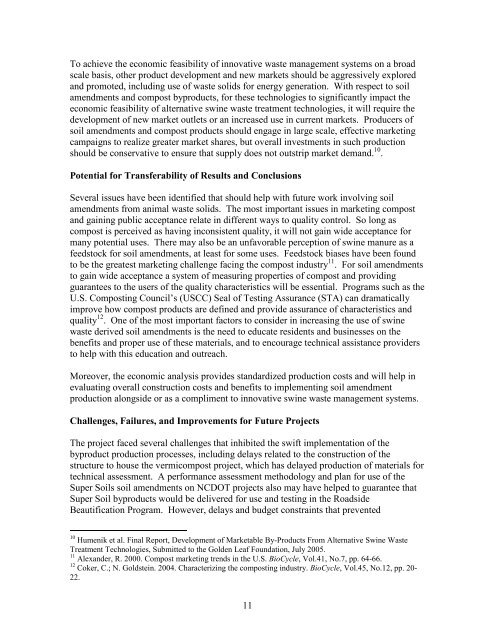Pilot Project for Value-Added Product Development from Solid ...
Pilot Project for Value-Added Product Development from Solid ...
Pilot Project for Value-Added Product Development from Solid ...
You also want an ePaper? Increase the reach of your titles
YUMPU automatically turns print PDFs into web optimized ePapers that Google loves.
To achieve the economic feasibility of innovative waste management systems on a broad<br />
scale basis, other product development and new markets should be aggressively explored<br />
and promoted, including use of waste solids <strong>for</strong> energy generation. With respect to soil<br />
amendments and compost byproducts, <strong>for</strong> these technologies to significantly impact the<br />
economic feasibility of alternative swine waste treatment technologies, it will require the<br />
development of new market outlets or an increased use in current markets. Producers of<br />
soil amendments and compost products should engage in large scale, effective marketing<br />
campaigns to realize greater market shares, but overall investments in such production<br />
should be conservative to ensure that supply does not outstrip market demand. 10 .<br />
Potential <strong>for</strong> Transferability of Results and Conclusions<br />
Several issues have been identified that should help with future work involving soil<br />
amendments <strong>from</strong> animal waste solids. The most important issues in marketing compost<br />
and gaining public acceptance relate in different ways to quality control. So long as<br />
compost is perceived as having inconsistent quality, it will not gain wide acceptance <strong>for</strong><br />
many potential uses. There may also be an unfavorable perception of swine manure as a<br />
feedstock <strong>for</strong> soil amendments, at least <strong>for</strong> some uses. Feedstock biases have been found<br />
to be the greatest marketing challenge facing the compost industry 11 . For soil amendments<br />
to gain wide acceptance a system of measuring properties of compost and providing<br />
guarantees to the users of the quality characteristics will be essential. Programs such as the<br />
U.S. Composting Council’s (USCC) Seal of Testing Assurance (STA) can dramatically<br />
improve how compost products are defined and provide assurance of characteristics and<br />
quality 12 . One of the most important factors to consider in increasing the use of swine<br />
waste derived soil amendments is the need to educate residents and businesses on the<br />
benefits and proper use of these materials, and to encourage technical assistance providers<br />
to help with this education and outreach.<br />
Moreover, the economic analysis provides standardized production costs and will help in<br />
evaluating overall construction costs and benefits to implementing soil amendment<br />
production alongside or as a compliment to innovative swine waste management systems.<br />
Challenges, Failures, and Improvements <strong>for</strong> Future <strong>Project</strong>s<br />
The project faced several challenges that inhibited the swift implementation of the<br />
byproduct production processes, including delays related to the construction of the<br />
structure to house the vermicompost project, which has delayed production of materials <strong>for</strong><br />
technical assessment. A per<strong>for</strong>mance assessment methodology and plan <strong>for</strong> use of the<br />
Super Soils soil amendments on NCDOT projects also may have helped to guarantee that<br />
Super Soil byproducts would be delivered <strong>for</strong> use and testing in the Roadside<br />
Beautification Program. However, delays and budget constraints that prevented<br />
10 Humenik et al. Final Report, <strong>Development</strong> of Marketable By-<strong>Product</strong>s From Alternative Swine Waste<br />
Treatment Technologies, Submitted to the Golden Leaf Foundation, July 2005.<br />
11 Alexander, R. 2000. Compost marketing trends in the U.S. BioCycle, Vol.41, No.7, pp. 64-66.<br />
12 Coker, C.; N. Goldstein. 2004. Characterizing the composting industry. BioCycle, Vol.45, No.12, pp. 20-<br />
22.<br />
11
















